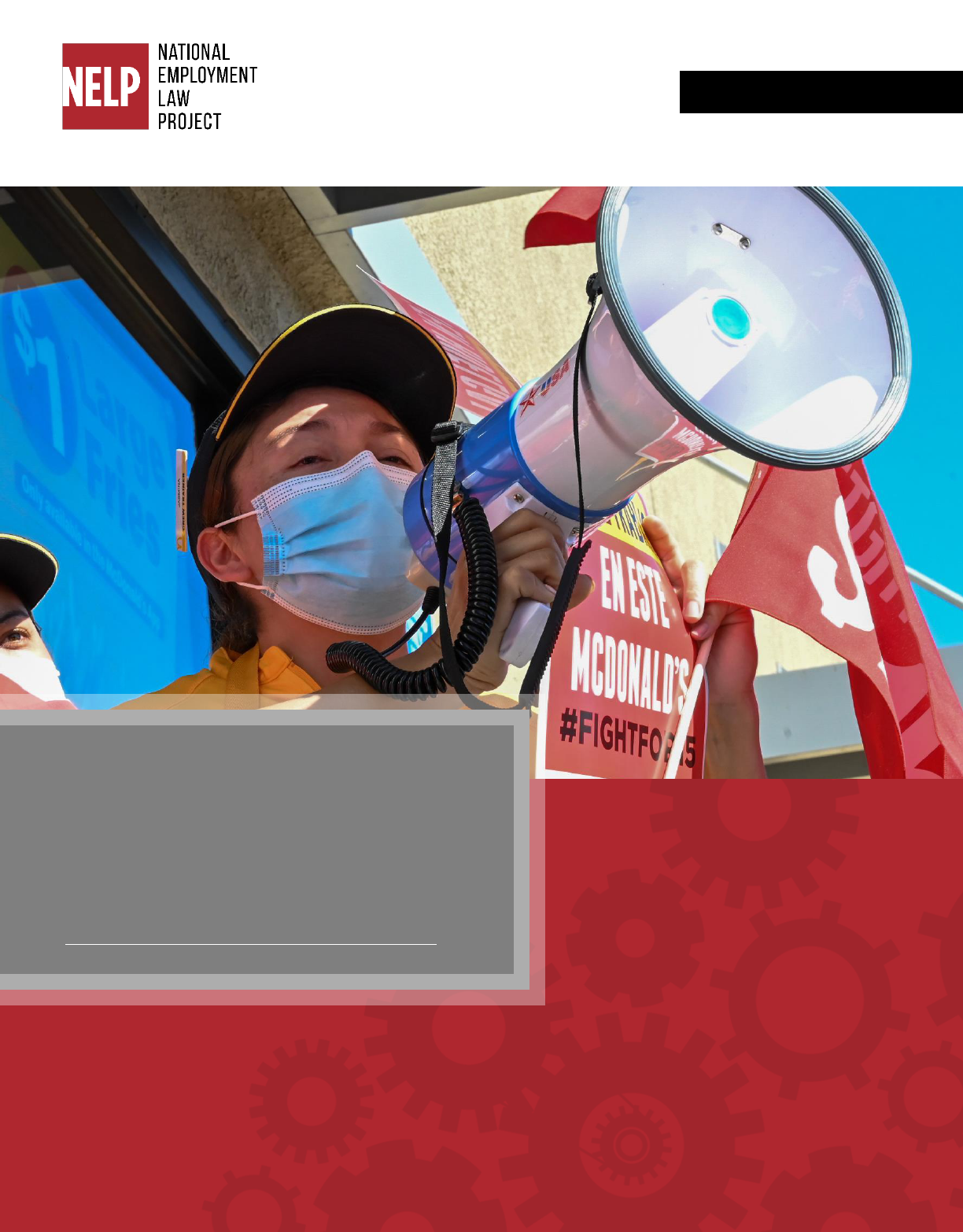
NELP | RETALIATION FUNDS: A NEW TOOL TO TACKLE WAGE THEFT | APRIL 2021
0
REPORT| NOVEMBER 2022
How California can
Lead on Retaliation
Reforms to Dismantle
Workplace Inequality
Authors:
Tsedeye Gebreselassie
Nayantara Mehta
Irene Tung

NELP | HOW CA CAN LEAD ON RETALIATION REFORMS TO DISMANTLE WORKPLACE INEQUALITY | NOV 2022
1
Acknowledgements
The authors would like to thank Ruth Silver Taube (Santa Clara County Wage Theft Coalition), Tia
Koonse (UCLA Labor Center), Christopher Calhoun and Azucena Garcia-Ferro (SEIU California),
and the membership and leadership of the California Coalition for Worker Power (CCWP) for
their contributions to this report. Photo credits: Fight for $15 and a Union, Trabajadores Unidos.
Special thanks to our former NELP colleague Laura Huizar, for her leadership in developing the
details of a retaliation fund.
We would also like to thank our NELP colleague Paul Sonn, for his contributions to policy
development on just cause protections, and colleagues Cynthia Montes, Mónica Novoa, Eleanor
Cooney, and Norman Eng for their expertise and support in the production of this report.
About NELP
Founded in 1969, the nonprofit National Employment Law Project (NELP) is a leading advocacy
organization with the mission to build a just and inclusive economy where all workers have
expansive rights and thrive in good jobs. Together with local, state, and national partners, NELP
advances its mission through transformative legal and policy solutions, research, capacity building,
and communications. For more information, visit us at www.nelp.org

NELP | HOW CA CAN LEAD ON RETALIATION REFORMS TO DISMANTLE WORKPLACE INEQUALITY | NOV 2022
2
Contents
Introduction ........................................................................................................................ 4
I. Few Workers Who Experience Workplace Violations Report Them, and the Majority of
Those that Do Report Experience Employer Retaliation as a Result .................................. 8
II. Workers Cite Concerns about Employer Retaliation and the Threat of Job Loss As Major
Reasons for Not Reporting Employer Violations ............................................................. 10
III. Given Widespread Economic Precarity in California, Retaliatory Firings Can Have
Catastrophic Consequences for Workers ......................................................................... 12
IV. California’s Anti-Retaliation Laws Fall Short Because They Force Workers to Bear
Significant Financial Risk Before Holding Employers Accountable ................................... 14
V. Unjust and Arbitrary Firings: California’s At-Will Employment System Creates an
Enormous Power Imbalance Between Workers and Employers, With Far Reaching
Consequences in the Workplace and Beyond .................................................................. 15
A. At-Will Employment Allows Employers to Fire Workers for Almost Any Reason or No
Reason at All 15
B. Unfair and Arbitrary Firings are Common 17
C. At-Will Employment Coerces Workers into Accepting Harmful and Illegal Working
Conditions 18
VI. Policy Recommendations: A Retaliation Hardship Fund, Consistency Across the Labor
Code, and a State “Just Cause” Standard ......................................................................... 19
A. Create a Retaliation Fund to Provide Workers with the Financial Support They Need
When an Employer Retaliates 19
B. Simplify California’s Anti-Retaliation Laws to Help Workers Understand and Assert
Their Rights 20
C. Adopt a State “Just Cause” Law to Protect Workers from Unfair and Arbitrary Firings
21
VII. Conclusion ......................................................................................................................... 21

NELP | HOW CA CAN LEAD ON RETALIATION REFORMS TO DISMANTLE WORKPLACE INEQUALITY | NOV 2022
3
Appendix A – Key Elements of a Retaliation Fund ........................................................... 22
Appendix B – Key Provisions of a “Just Cause” Law .......................................................... 25
Appendix C – Survey Methodology ................................................................................... 29
Endnotes ........................................................................................................................... 30

NELP | HOW CA CAN LEAD ON RETALIATION REFORMS TO DISMANTLE WORKPLACE INEQUALITY | NOV 2022
4
Introduction
“I think of my family. One has to work to survive. In this country and in this state, it is too
expensive. Rent, food, everything is very expensive. But it is true that I have seen so
much injustice, sometimes it even gives me fear, [but] I think, ‘What job am I going to
find?’ because I have seen over the years that in the fast food industry there is a lot of
discrimination, wage theft, many injustices that all workers experience. So that's why I
like to participate, because this fear truly has to end. Being able to raise my voice has
served a lot to my colleagues. They have followed me, been with me, and they have been
able to raise their voices too.”
1
“After our boss knew that we were taking collective action, she was furious and began to
cut our hours, give us the hardest shifts, like the closing shifts, and even fired employees.
Retaliation is so common because many immigrant workers don’t know their rights. We
need to ensure a safe workplace and protection from retaliation, especially during this
pandemic, when restaurant workers have to interact with customers and may be scared
to speak up. I hope that other workers will hear our story and learn and protect their
rights.”
2
Workers across California in sectors such as food service, car wash, and caregiving are
coming together to fight for owed wages and safer working conditions. The quotes
above come from, respectively, the Fight for 15-led campaign for better conditions in
the fast-food industry and a three-year organizing campaign supported by the Chinese
Progressive Association and the Asian Law Caucus, which resulted in 22 restaurant
workers recovering $1.6 million in stolen wages.
These campaigns are powerful examples of worker action and solidarity. However, there
remains a fundamental power imbalance between workers and employers that makes it
difficult for workers to raise complaints and take collective action to improve workplace
conditions. Because employers can fire workers for almost any reason—or for no reason
at all—under California’s system of “at will” employment, workers often experience
retaliation when speaking up about workplace conditions. Widespread economic
insecurity makes the threat of losing one’s job or income as a result of employer
retaliation especially and immediately catastrophic.
To better understand the impact of employer retaliation and at-will firings in California,
the National Employment Law Project (NELP) commissioned YouGov to conduct a survey
of 1,000 adults in the California workforce in January 2022. The survey sample included
workers aged 18-64 across the income spectrum and was representative by age, gender,
race, and years of education. Survey responses revealed a high prevalence of workplace
violations, low rates of violation reporting, high rates of employer retaliation, and
frequent unfair and arbitrary firings. Key findings include:
• Thirty-eight percent of California workers have experienced a workplace
violation.
»

NELP | HOW CA CAN LEAD ON RETALIATION REFORMS TO DISMANTLE WORKPLACE INEQUALITY | NOV 2022
5
• Only 10 percent of those workers reported them to a government agency, and
almost half (47 percent) did not report violations to anyone.
• Of the workers who reported violations to their employer or to a government
agency, a majority (116 of 216 respondents) experienced employer retaliation.
• Fifty-one percent of working Californians said that concern about employer
retaliation would influence their decision about whether or not to report a
workplace violation in the future.
• More than two in three California workers said access to a hardship fund that
would provide them immediate monetary relief if they were retaliated against
could help them report a future violation to a government agency.
• An overwhelming majority of working Californians—92 percent—support the
establishment of a retaliation hardship fund that would provide one-time
financial assistance to workers who file good faith complaints about employer
retaliation.
• Forty-one percent of California workers have been fired or let go at some point.
Less than one third of those workers (29 percent) said they were given fair
warning before being fired, and most (64 percent) said they have never received
severance pay.
• More than 40 percent of workers—including 46 percent of Latinx workers and
55 percent of Black workers—said that concern about being fired or disciplined
may have prevented them from joining their co-workers to push for job
improvements.
• A large majority of working Californians of all political parties—81 percent—
support the adoption of laws protecting workers from unfair and arbitrary
firings.
This report builds on the survey’s findings to examine how retaliation and unfair firings
permitted under today’s at-will employment framework put workers at a fundamental
disadvantage when it comes to exercising their rights. The report highlights the costs of
this power imbalance for workers and their broader communities and offers the
following policy recommendations to California lawmakers:
• Establish a retaliation fund to provide workers with the immediate economic
support they need to exercise their rights.
• Bring the state’s varied and complex array of anti-retaliation laws into harmony
and ensure that the same protections for workers exist across the California
Labor Code.
• Create a rebuttable presumption of retaliation within 90 days and ensure that
penalties for retaliation consistently go directly to the worker rather than to the
state’s general fund.

NELP | HOW CA CAN LEAD ON RETALIATION REFORMS TO DISMANTLE WORKPLACE INEQUALITY | NOV 2022
6
• Increase funding for the Labor Commissioner’s Retaliation Complaint
Investigation Unit to support its enforcement of more than 45 labor laws.
• Adopt a “just cause” policy to address arbitrary and unfair firings.
The first two sections of the report detail the survey’s findings that few workers who
experience workplace violations actually report it, and of those that do, a majority
experience employer retaliation as a result. These findings are borne out by complaint
data collected from the state’s main workplace enforcement agencies. This retaliation is
a major reason why workers do not come forward. The third section of the report
describes some of the immediate catastrophic consequences that flow from employer
retaliation, with many workers already just a paycheck or two away from being unable
to cover their bills. Section 4 highlights some of the inadequacies in existing state anti-
retaliation laws that force workers to bear significant financial risk before holding
employers accountable. Section 5 situates workers’ experiences in California’s at-will
employment system, where most employers can legally fire workers with no notice for
almost any reason or no reason at all. At-will employment creates a climate of fear that
undermines workers ability to speak up about mistreatment, and perpetuates
longstanding racial inequities in the workplace. The survey’s data confirms this, finding
that unfair and arbitrary firings are common among California’s workforce and that the
threat of these firings coerces workers into accepting harmful working conditions.
Finally, Section 6 offers the policy recommendations listed above.
Why Do Workers Experience Retaliation?
Numerous studies confirm that workers, especially those in low-paying industries,
experience high rates of workplace violations, including wage and hour violations,
unsafe working conditions, and more. But workers in the US generally bear the burden of
enforcing their own labor protections—worker complaints are virtually the only way that
violations are brought to the attention of public agencies or the courts. When a worker
comes forward to report a workplace violation, we know that employers often retaliate
or threaten to retaliate against the worker. Under our current system, workers bear the
entire risk of retaliation from their employer when they report violations.
What Does Retaliation Look Like?
Retaliation takes many shapes and can be difficult to pinpoint or prove. Employers, for
example, may fire a worker, demote a worker, reduce a worker’s hours, change a
worker’s schedule to a less favorable one, subject a worker to new forms of harassment,
unfairly discipline a worker, threaten to report a worker or a worker’s family member to
immigration authorities, blacklist workers from future employment, and much more.

NELP | HOW CA CAN LEAD ON RETALIATION REFORMS TO DISMANTLE WORKPLACE INEQUALITY | NOV 2022
7
What Does Retaliation Cost Workers?
When workers experience retaliation for trying to protect their rights, the costs can
quickly escalate from both a financial and emotional standpoint, especially for the
countless workers nationwide who live paycheck to paycheck. A worker may experience
lost pay, for example, which can lead to missed bill payments, lower credit scores,
eviction, repossession of a car or other property, suspension of a license, inability to pay
child support or taxes, attorney’s fees and costs, stress, trauma, and more.
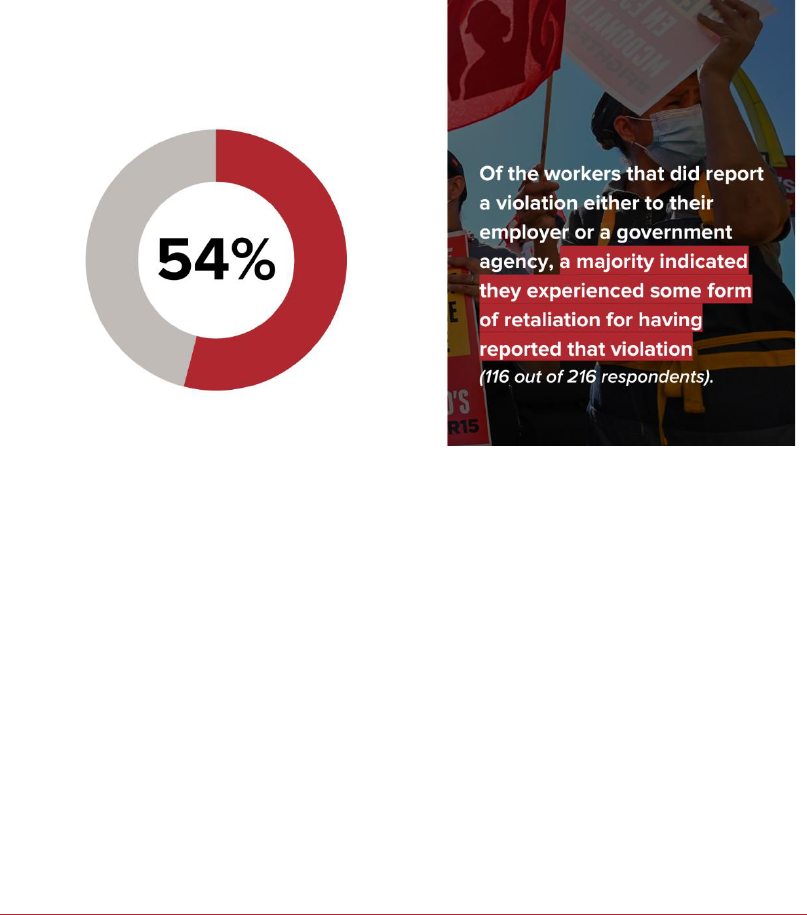
NELP | HOW CA CAN LEAD ON RETALIATION REFORMS TO DISMANTLE WORKPLACE INEQUALITY | NOV 2022
8
I. Few Workers Who Experience Workplace Violations Report
Them, and the Majority of Those that Do Report Experience
Employer Retaliation as a Result
Our survey of California’s workforce found that 38 percent of respondents have
experienced a workplace violation, but only 10 percent of those respondents reported
the violation to a government agency. While more than a quarter (26 percent) have
reported a violation to human resources and 29 percent have reported a violation to
their supervisor, almost half (47 percent) of workers who experienced violations did not
report them to anyone.
Of the workers who did report a violation, either to their employer or to a government
agency (216 respondents), a majority (116 out of 216 respondents) indicated they
experienced some form of retaliation for having reported that violation.
State agency data, detailed below, corroborate our findings that employer retaliation is
a serious problem in California with California enforcement agencies receiving tens of
thousands of complaints each year alleging unlawful retaliation. Three of the principal
agencies tasked with handling retaliation complaints for California workers are the US
Equal Employment Opportunity Commission (EEOC), the Retaliation Complaint
Investigation Unit (RCI) within the California Labor Commissioner’s Office, and the
California Civil Rights Department (formerly the Department of Fair Employment and
Housing) (CRD). The EEOC handles complaints concerning workplace discrimination and
related retaliation under various federal laws,
3
RCI enforces over four dozen California
retaliation protection statutes,
4
and the CRD enforces the Fair Employment and Housing
Act, Unruh Civil Rights Act, Disabled Persons Act, Ralph Civil Rights Act, Trafficking
Victims Protection Act, and other anti-discrimination laws involving state-funded
activities, along with retaliation stemming from workers’ reliance on those laws.
5

NELP | HOW CA CAN LEAD ON RETALIATION REFORMS TO DISMANTLE WORKPLACE INEQUALITY | NOV 2022
9
Data from these agencies spanning 2017 through 2019 shows:
• California workers submitted more than 69,000 complaints alleging retaliation to
the EEOC, RCI, and CRD.
• In 2019 alone, the EEOC, RCI, and CRD received more than 24,000 complaints
from California workers alleging unlawful retaliation.
• At the EEOC and CRD, retaliation complaints made up a significant share of all
employment-related complaints.
• Retaliation complaints accounted for more than 50 percent of all charges filed
with the EEOC.
• Retaliation complaints made up between 11 and 26 percent of employment-
related complaints submitted to CRD for investigation.

NELP | HOW CA CAN LEAD ON RETALIATION REFORMS TO DISMANTLE WORKPLACE INEQUALITY | OCT. 2022
10
See Table 1 for more details on retaliation complaints submitted to the EEOC, RCI, and CRD
based on publicly available data.
Table 1.
Retaliation Complaints Submitted in California, 2017-2020
Agency
2017
2018
2019
2020
US Equal
Employment
Opportunity
Commission
6
2,752
(50.7% of all
state charges)
2,183
(50.3% of all
state charges)
2,319
(54.2% of all
state charges)
2,306
(55.8% of all
state charges)
Retaliation
Complaint
Investigation Unit
within California
Labor
Commissioner’s
Office
4,178
7
5,633
8
6,515
9
5,334
10
California Civil
Rights Department
1,094
11
retaliation
complaints for
investigation
(11% of all
employment
complaints)
2,785
12
retaliation
complaints for
investigation
(26% of all
employment
complaints)
2,717
13
retaliation
complaints for
investigation
(19% of all
employment
complaints)
8,468
14
retaliation
basis in
complaints
seeking a
right-to-sue
17,697
15
retaliation
basis in
complaints
seeking a
right-to-sue
13,181
16
retaliation
basis in
complaints
seeking a
right-to-sue
TOTAL
16,492
28,298
24,732
Total (2017-
2020): 69,522
II. Workers Cite Concerns about Employer Retaliation and the
Threat of Job Loss As Major Reasons for Not Reporting
Employer Violations
Even as state enforcement agencies receive tens of thousands of retaliation complaints per
year, our survey findings and previous research in California reveal that filed complaints are
just the tip of the iceberg when it comes to workplace violations and retaliation. Of the
almost one in two California workers who experienced violations but did not report them, a
majority (96 out of 179) indicated that concern about retaliation was a deterring factor.
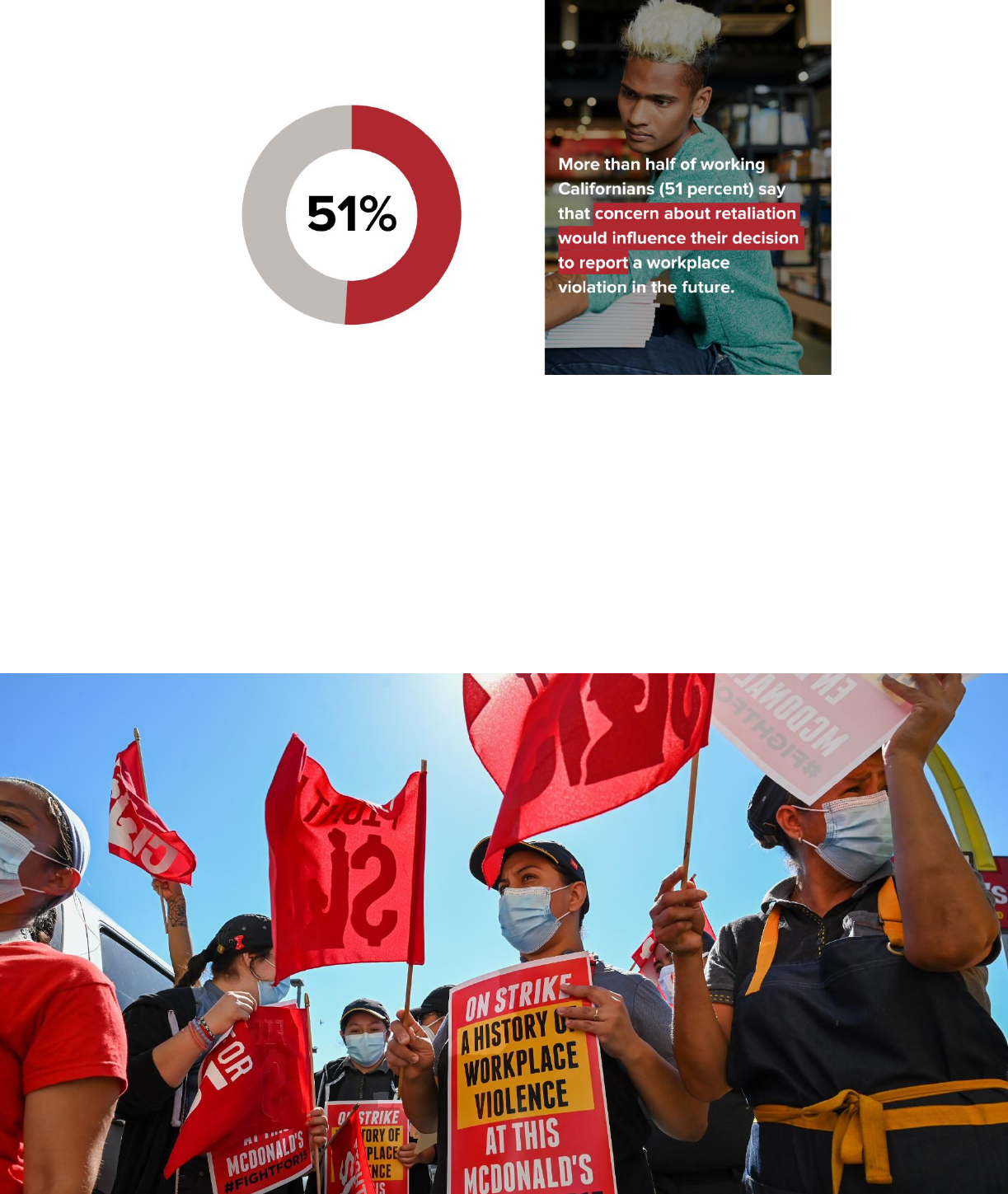
NELP | HOW CA CAN LEAD ON RETALIATION REFORMS TO DISMANTLE WORKPLACE INEQUALITY | NOV 2022
11
More than 4 out of 10 survey respondents reported that concern about employer
retaliation has possibly stopped them from speaking up about dangerous or unhealthy
working conditions in the past. Black and Latinx workers were more likely than white
workers to say that this was the case. Forty-nine percent of Black workers and 45 percent
of Latinx workers indicated this was their experience, compared to 39 percent of white
workers. Finally, more than half of working Californians (51 percent) said that concern
about employer retaliation would influence their decision about whether or not to report a
workplace violation in the future. These results show that retaliation concerns keep many
workers from coming forward. Previous California worker surveys have presented similar
findings.
17
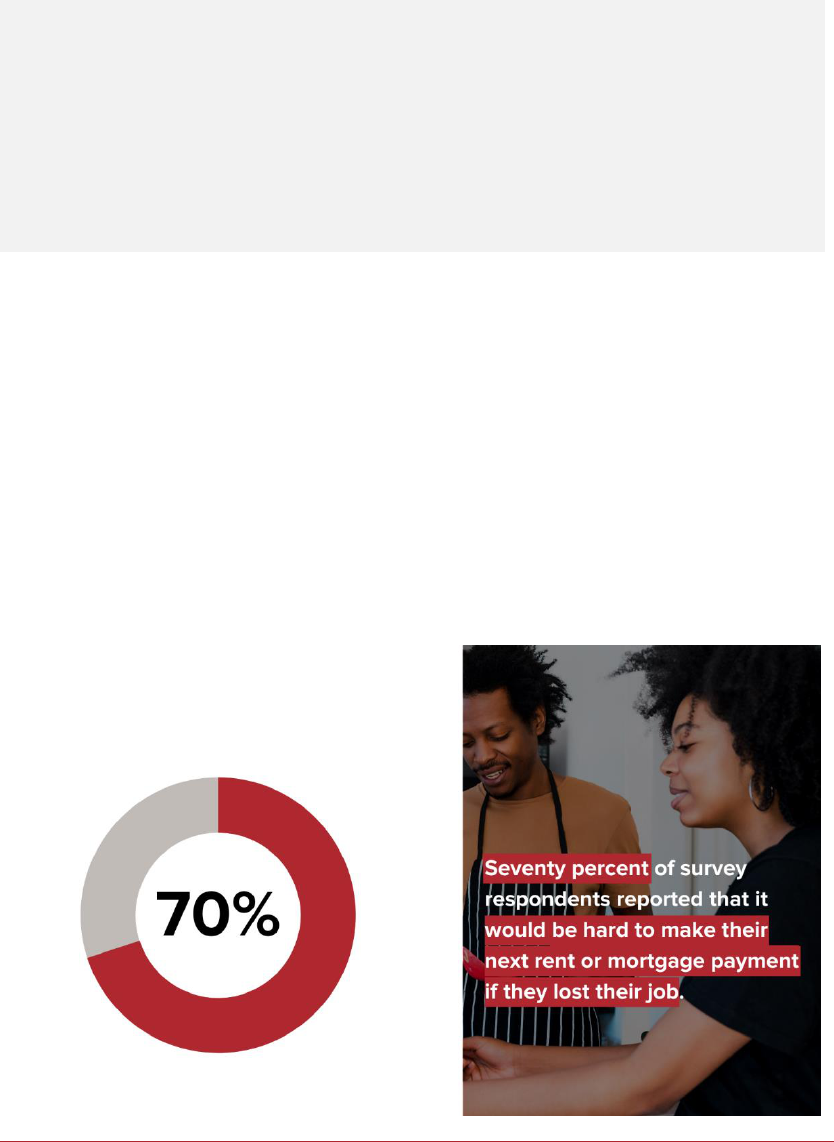
NELP | HOW CA CAN LEAD ON RETALIATION REFORMS TO DISMANTLE WORKPLACE INEQUALITY | NOV 2022
12
III. Given Widespread Economic Precarity in California, Retaliatory
Firings Can Have Catastrophic Consequences for Workers
Members of the Pilipino Association of Workers and Immigrants described in focus group
conversations that their economic needs and the need to have a job keep them in jobs
where their rights are violated and where they endure conditions harmful to their health:
“Even if it isn’t true, employers say that if you go to the Labor Commission, you won’t be
able to find a job. The employers have an association and have a blacklist of workers who
filed claims.”
“We are not even paid the minimum wage, but we have tons of bills to pay. We don’t have
medical insurance. Our priority is remitting money back home, but, with low wages and
bills, we don’t have much money to send home. We end up having to take second and third
jobs. We end up getting sick. When I was 40, it wasn’t so bad, but now that I am 50, I have
back pain and neck pain.”
18
With many workers just a paycheck or two away from not being able to pay their bills, the
real threat of being fired or having pay or hours cut can factor heavily in a worker’s decision
about whether to come forward with concerns.
Our survey found that 40 percent of the California workforce would be unable to cover a
month or less of regular expenses if they lost their job. Seventy percent reported that it
would be hard to make their next rent or mortgage payment, with nearly half of those
reporting that it would be “very” hard.
Among survey respondents who had prior job losses, 79 percent also reported significant
economic hardship from those job losses, including not being able to pay bills on time (40
percent), seeking food from a food bank (20 percent), delaying health care or medication

NELP | HOW CA CAN LEAD ON RETALIATION REFORMS TO DISMANTLE WORKPLACE INEQUALITY | NOV 2022
13
(22 percent), and using all their savings (36 percent).
These survey results are consistent with numerous other reports detailing the economic
insecurity of California’s workforce. For example, according to the California Future of
Work Commission’s March 2021 report, the majority of renter households in the state pay
more than 30 percent of their income toward housing.
19
According to the Northwestern
Institute for Policy Research and the California Association of Food Banks, about one in
every five Californians experiences food insecurity, meaning that they “do not know where
their next meal will come from — with greater levels of hunger experienced by Black and
Latinx families.”
20
According to a Public Religion Research Institute study of California
workers, almost half (47 percent) of California workers struggle with poverty, and they are
more likely to be Latinx workers (60 percent of Californians who work and struggle with
poverty are Latinx).
21
Workers in California and across the country lack adequate emergency savings that could
help them weather even a brief interruption in work. For example, a 2019 AARP national
study found that 53 percent of households do not have an emergency savings account and
highlighted how “people of color in the United States face a massive wealth gap compared
to whites, and women have significantly less wealth than men.”
22
It cited a Federal Reserve
finding that “the median [B]lack family had just $3,600 in household wealth in 2018, the
median Latino family had $6,600, and the median white family had $147,000.”
23
In 2018,
the Federal Reserve reported that 4 in 10 adults would have difficulty covering a
hypothetical unexpected expense of $400.
24
More broadly, the Federal Reserve found that
3 in 10 adults are “either unable to pay their bills or are one modest financial setback away
from hardship.”
25
Making matters worse, most California workers lack access to a meaningful safety net if
they lose their job or part of their income.
First, while severance pay policies can sometimes provide some immediate financial
support for workers who are laid off or who voluntarily resign, most workers across the
income spectrum do not have access to such pay. Our survey found that only 14 percent of
California workers who had lost jobs received severance pay after every job loss. Sixty-four
percent of workers who lost jobs have never received severance pay.
Second, while an essential program, California’s unemployment system does not offer
workers reassurance that they can obtain quick and meaningful economic support in case
of job loss. California workers may receive a maximum of only $450 per week in
unemployment benefits. The California Budget & Policy Center has illustrated how that
amount falls far short of what California workers need to support their families and look for
work.
26
For “the majority of California renters with low incomes who spend at least half of
their income on rent,” current benefit levels mean that they would have to spend their
entire unemployment benefit to pay rent alone without other income.
27
In addition, as the
COVID-19 pandemic has starkly exposed, the California unemployment system is plagued
by outdated infrastructure, long delays for benefits, abrupt suspensions, and concerns
about fraud.
28
Even if the system worked efficiently for workers, a successful application for
benefits still relies on employers “to exchange information that is necessary in determining

NELP | HOW CA CAN LEAD ON RETALIATION REFORMS TO DISMANTLE WORKPLACE INEQUALITY | NOV 2022
14
eligibility” with the Employment Development Department.
29
Workers who have been fired
in retaliation will not generally expect their employer to cooperate with a request for
unemployment assistance. Employers may even falsely report that a worker was fired for
misconduct, making a worker initially ineligible for unemployment benefits and forcing
them to appeal the denial, delaying benefits even longer. Furthermore, undocumented
immigrant workers remain ineligible for unemployment benefits.
30
This economic precarity heavily influences whether workers decide to raise workplace
concerns, especially in an employment-at-will framework where employers can fire
workers without cause and in an environment where protections against retaliation are
inadequate and do not mitigate the immediate financial harm that comes with being fired,
demoted, blacklisted, or otherwise punished for coming forward.
IV. California’s Anti-Retaliation Laws Fall Short Because They Force
Workers to Bear Significant Financial Risk Before Holding
Employers Accountable
A 2019 NELP 50-state survey of anti-retaliation laws tied to the reporting of minimum wage
or other wage-theft violations showed that California is one of a handful of states where
the statutes include provisions that NELP considers minimally necessary to help deter
retaliation and provide meaningful remedies for workers: a private right of action; state
monetary penalties; attorneys’ fees and costs for workers who file lawsuits; and both
compensatory and punitive damages for workers.
31
The California Labor Commissioner
alone is charged with enforcing over four dozen anti-retaliation statutes.
32
One of those
relatively strong statutes is California Labor Code Section 98.6, which requires employers to
pay up to $10,000 in penalties to workers who suffered retaliation, and Labor Code Section
1102.6, which shifts the burden of proof under Labor Code 1102.5 (the whistleblower
statute) to the employer to demonstrate by clear and convincing evidence that there was a
legitimate, independent reason for the adverse action.
33
And a number of other California
statutes stand out nationally, such as those that expressly prohibit various forms of
immigration-based retaliation
34
and do not require an adverse action and the recent 2017
amendment (SB 306) that allows the Labor Commissioner to seek a preliminary court
injunction to stop retaliation with “reasonable cause” to believe a discrimination or
retaliation violation has occurred.
35
These types of valuable tools should continue to form
key components of any effort to fight retaliation.
However, despite various strengths, none of California’s anti-retaliation laws provide
workers who experience retaliation with monetary relief when they need it most:
immediately or soon after an employer retaliates.
After experiencing retaliation, a worker must generally file a new complaint alleging
unlawful retaliation. At that point, the worker assumes a difficult legal burden of proving
that retaliation happened,
36
and retaliation investigations and litigation can take months or
years before reaching a final decision. The CRD reported in 2019 that even after reducing
the average number of days for the agency to close a case, the 2018 average was still 109

NELP | HOW CA CAN LEAD ON RETALIATION REFORMS TO DISMANTLE WORKPLACE INEQUALITY | NOV 2022
15
days.
37
In 2018, more than 6,000 CRD cases experienced a wait of 30 days or more just to
complete the intake interview.
38
A FY 2019 report on California’s Occupational Safety and
Health program performance found that the California Division of Labor Standards
Enforcement completed only one percent of its investigations within 90 days and that the
average number of days for investigation completion was 582.
39
The EEOC informs
complainants that the agency takes “approximately 10 months to investigate a charge.”
40
And even when a court or agency finally orders an employer to pay a worker monetary
damages after retaliation, getting an employer to actually pay the judgment presents its
own challenge.
41
In sum, by the time a worker obtains any relief from a retaliation investigation or lawsuit in
California (if they do at all), a worker who was fired for reporting a violation or whose
employer reduced their pay (e.g., by cutting hours or assigning a worker to a less desirable
shift with fewer tip earnings) has suffered potentially devastating and long-term economic
consequences. When workers across the state generally have little or no job security and
most cannot afford even a $400 emergency, one missed or reduced paycheck can quickly
snowball into a missed rent or mortgage payment; eviction; cut utilities; an inability to
provide food, medicine, or school supplies for their children; a reduced credit score; late
fees; unpaid child support or unpaid traffic fines with their own punitive repercussions; and
more. This economic risk compounds the other serious risks that workers face when
asserting their rights. When an employer retaliates, workers often endure painful
emotional distress, ongoing harassment, or other unfair treatment at work. And workers
who face detention or deportation because their employer reported them to immigration
authorities experience uniquely traumatic consequences and potentially permanent
separation from their families and community.
V. Unjust and Arbitrary Firings: California’s At-Will Employment
System Creates an Enormous Power Imbalance Between
Workers and Employers, With Far Reaching Consequences
in the Workplace and Beyond
A. At-Will Employment Allows Employers to Fire Workers for Almost Any Reason or No
Reason at All
One major reason that California workers lack strong protection from retaliation is that
employers can generally fire workers for any reason or no reason at all, unless otherwise
explicitly prohibited by law. Without protection from arbitrary and unfair firings, workers
have a much harder time speaking up on the job and enforcing their rights.
42
And even
when the law prohibits retaliatory firings for workers who file complaints with government
agencies or organize at their workplaces, employers can easily deny that firings are
motivated by retaliation and point to any other arbitrary reason as the impetus for firing.
The US is unique among industrialized nations in that employees can be fired abruptly—without
notice, a chance to address employment problems, or even a stated reason—and left with bills
due and no paycheck or severance pay. By contrast, Australia, Brazil, Japan, Mexico, the United

NELP | HOW CA CAN LEAD ON RETALIATION REFORMS TO DISMANTLE WORKPLACE INEQUALITY | NOV 2022
16
Kingdom, and most of the European Union, among many other countries, require employers to
provide workers with a sufficient reason for termination.
43
In the US, employment termination policies are generally regulated by state jurisdictions.
Currently in California, employment is presumed to be at-will, meaning that an employer may
discharge a worker at any time, without any reason or cause so long as no other law or
employment contract is violated.
The at-will employment doctrine that allows employers to legally fire workers without
warning or explanation was not determined through any democratic legislative process.
Instead, conservative judges gradually imposed the doctrine through judicial rulings in the
decades following the passage of the 13th Amendment, which banned slavery and most
forms of servitude.
44
A century and a half later, at-will employment still underpins the power imbalance
between employers and workers. While both workers and employers take on a certain
amount of risk when they enter an employment relationship, workers take on greater risk
because their livelihood is at stake. In addition to not needing to give advance notice or
justification for termination, employers also do not have to set clear performance
standards, apply rules or expectations consistently, or even inform workers of how
discipline or termination decisions are made. This stymies complaint-driven enforcement of
workplace laws because workers have to weigh any action they take against the possibility
of discipline and termination.
Lack of job-security protections also compounds the negative effects of systemic racism in
the workplace and the labor market. Workers of color—especially Black and Latinx
workers—face widespread systemic racism and segregation in the workplace and labor
market, including a high prevalence of discrimination in the hiring process, on the job, and
in disciplinary matters.
45
These circumstances mean that workers of color must contend
with heightened challenges in an at-will employment system. Black workers—who are the
“last hired, and first fired”—especially bear the brunt of the job insecurity caused by at-will
firings.
46
Our survey of the California workforce provides insight into unfair firings in the state,
revealing how widespread the problem is and the many negative impacts for workers,
families, and communities.
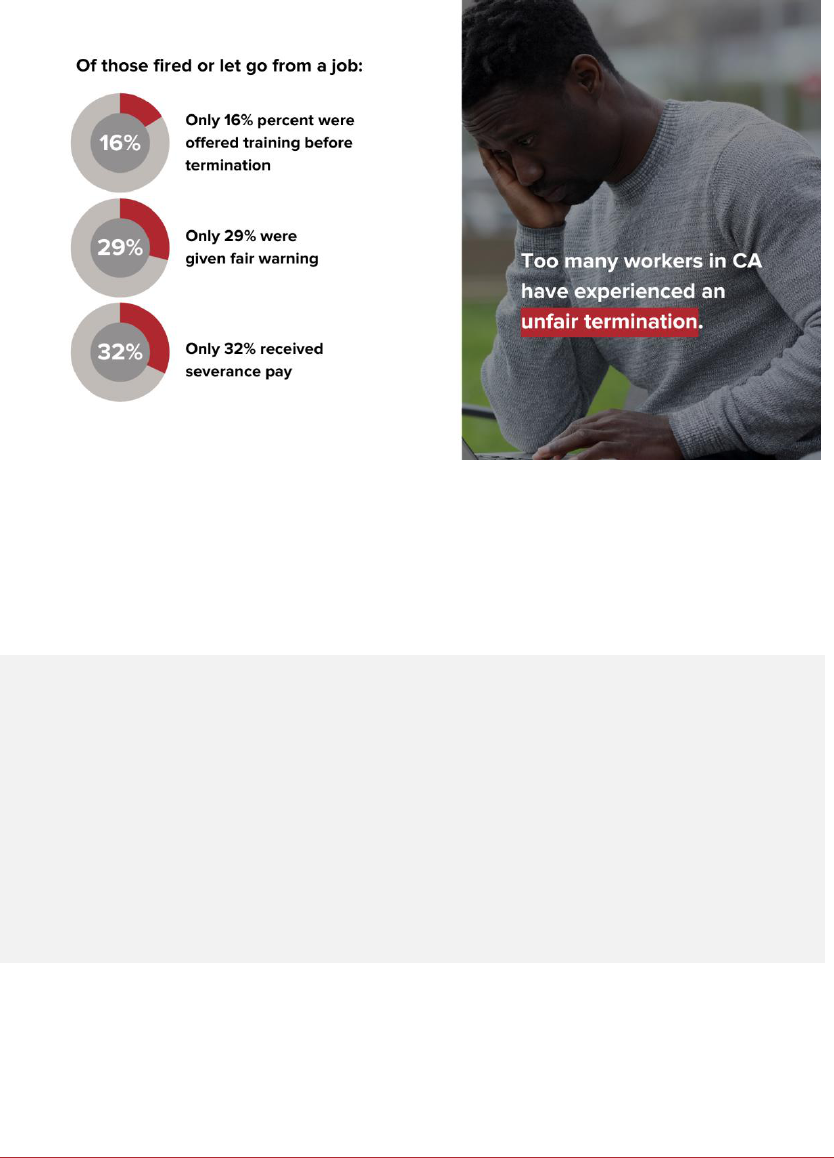
NELP | HOW CA CAN LEAD ON RETALIATION REFORMS TO DISMANTLE WORKPLACE INEQUALITY | NOV 2022
17
B. Unfair and Arbitrary Firings are Common
Our findings show that an alarmingly large share of workers in California have experienced
an unfair termination. More than 4 in 10 California workers have been fired or let go from a
job at some point, and only 29 percent of those workers were given fair warning.
Of workers who were fired or let go, just 16 percent said they were offered more training
before termination. And fewer than one in three received severance pay.
A participant in the focus groups conducted with members of the CLEAN Carwash Worker
Center described an experience of being fired after taking part in an investigation:
“I worked at the [NAME OF EMPLOYER WITHHELD] for several years. During my time there
an investigation began by the state of California to look into the conditions of work at the
business. At this car wash, we did not have fixed hours of work. We were asked to arrive
early and wait in an alley for work, sometimes for hours. We were never paid for this time. I
was one of the worker leaders during the time and always shared what was happening at
the car wash with the investigators. That was why they fired me on [DATE WITHHELD].
When that happened, I asked my manager why he was firing me. He said it was simply
because there was no longer work for me. But they always told me that I was one of their
best workers. I came back the next day and said, ‘Did you fire me for speaking up on the job,
for standing up for my rights, and fighting to improve the work conditions here?’ But of
course, he only repeated that I was no longer needed at the car wash.”
47
Workers are aware that there is a risk of being fired anytime, even if not filing a formal
complaint. When describing what she feels about work, one participant in a focus group
with members of the Pilipino Worker Center said:

NELP | HOW CA CAN LEAD ON RETALIATION REFORMS TO DISMANTLE WORKPLACE INEQUALITY | NOV 2022
18
“For me, what I think about and bothers me is that our employer can fire us at any time
they want to. What’s more they have favoritism. That, I worry about.”
48
C. At-Will Employment Coerces Workers into Accepting Harmful and Illegal Working
Conditions
At-will firings enable employers to use the threat of termination as a form of economic
coercion. Under the at-will system, if workers fear the threat of unfair discipline or
dismissal from managers, they will be more likely to accept low pay, unfavorable terms of
employment, and poor working conditions; this is especially true for those with the least
power in the labor market. Some may also feel pressure to accept illegal situations such as
wage theft or health and safety hazards. Even if employers are not violating any actual
laws, at-will employment can create pressure for workers to behave in ways that are
detrimental to their well-being, such as deprioritizing their health needs, consenting to
undesired overtime hours, refraining from taking time off, or enduring verbal abuse.
Our survey bears this out, with a significant share of California workers reporting pressure
in their workplace to accept harmful and even illegal working conditions. Seventy-three
percent of respondents worked while sick to avoid being fired. Forty-three percent
reported that an employer pressured them to accept wage theft, or that they worked extra
hours without pay to avoid being fired. More than a third (34 percent) of workers accepted
pay that was less than what they were owed to avoid being fired.
Additionally, 39 percent of workers reported experiencing hazardous or unsafe working
conditions, and 35 percent reported working at a dangerous or unreasonable pace,
because of concern about possibly losing their jobs. Almost half (47 percent) of workers
have endured verbal hostility from a manager or supervisor without saying anything, and
two out of three workers (68 percent) also reported skipping breaks to avoid being fired.
More than half of respondents (53 percent) reported not asking for pay increases or
benefits they felt they deserved for fear of job loss. Forty-two percent said that termination
concerns also silenced them from speaking up about dangerous and unhealthy working
conditions. And more than 40 percent of workers—including 46 percent of Latinx workers
and 55 percent of Black workers—said that concern about being fired or disciplined may
have prevented them from joining with their co-workers to push for job improvements.
These findings show in vivid detail how at-will employment goes hand in hand with
exploitative working conditions. As one caregiving worker explained in a Pilipino Worker
Center focus group:
“If you complain, the agency will tell you, ‘Okay, will you like us to get another caregiver?
Because either you like it or not. You do the job, we’re going to pay you. That’s it. If you
cannot do the job, we’re going to find another one.’”
49
A sushi delivery driver in a focus group conducted by the Chinese Progressive Association
described being fired simply for raising a question about a delivery route:

NELP | HOW CA CAN LEAD ON RETALIATION REFORMS TO DISMANTLE WORKPLACE INEQUALITY | NOV 2022
19
“I’d have to deliver from the warehouse to pick up sushi from South San Francisco, then
deliver in San Francisco and Berkeley and Alameda County. The route takes a lot of time to
deliver. I didn’t complain to the employer, but in the last week of my job, my route included
delivery to San Jose. It didn’t make sense since it was a different direction from my route,
and I told my employer. He wasn’t happy with what I told him. The next day he didn’t give
me a work schedule. The employer pretty much fired me. That day the boss told me to
return the company car keys, and I will send someone to go to your home to retrieve the
car. (Did they give any explanation why you were fired?) No.”
50
People who have been formerly incarcerated by the US’s anti-Black criminal legal system
experience particular employment pressures that often cause them to accept poor working
conditions. Probation, parole, and other court-surveillance and supervision programs
regularly mandate maintaining or seeking employment as a standard set of conditions to
remain free from incarceration. Twenty-five percent of state prison admissions are due to
“technical rule violations” of parole.
51
Technical rule violations are not allegations of a new
criminal offense but are violations of parole rules that regularly include passing alcohol
and/or drug tests; satisfactory payment of criminal justice debt; completing court-
mandated classes; maintaining curfew; and seeking and maintaining employment.
52
This
threat of reincarceration drives many court-surveilled workers to enter and remain in jobs
with depressed labor standards and to avoid speaking up about illegal working conditions.
VI. Policy Recommendations: A Retaliation Hardship Fund,
Consistency Across the Labor Code, and a State “Just Cause”
Standard
California’s current legal system for handling workplace violations demands too much from
workers and fails to curb widespread wage theft, discrimination, and unsafe and unfair
working conditions. The state can more effectively support workers by addressing arbitrary
firings, retaliation, and the financial consequences of employer retaliation.
A. Create a Retaliation Fund to Provide Workers with the Financial Support They Need
When an Employer Retaliates
California lawmakers should address the critical gap in today’s anti-retaliation laws that
leaves workers without economic support when they need it most, through a state-funded
retaliation fund.
A retaliation fund would allow a worker who has reported a workplace violation to a state
agency to access quick, meaningful, and one-time financial assistance if their employer
retaliates against them (e.g., by firing, cutting pay or hours, demotion, blacklisting, etc.).
The fund would directly fill the urgent gap left by California’s existing anti-retaliation
statutes, under which it can take months, if not years, for a worker to obtain financial
support and a final decision on a retaliation complaint. The fund could draw on state
general funds for an initial period of time and eventually be funded through penalties
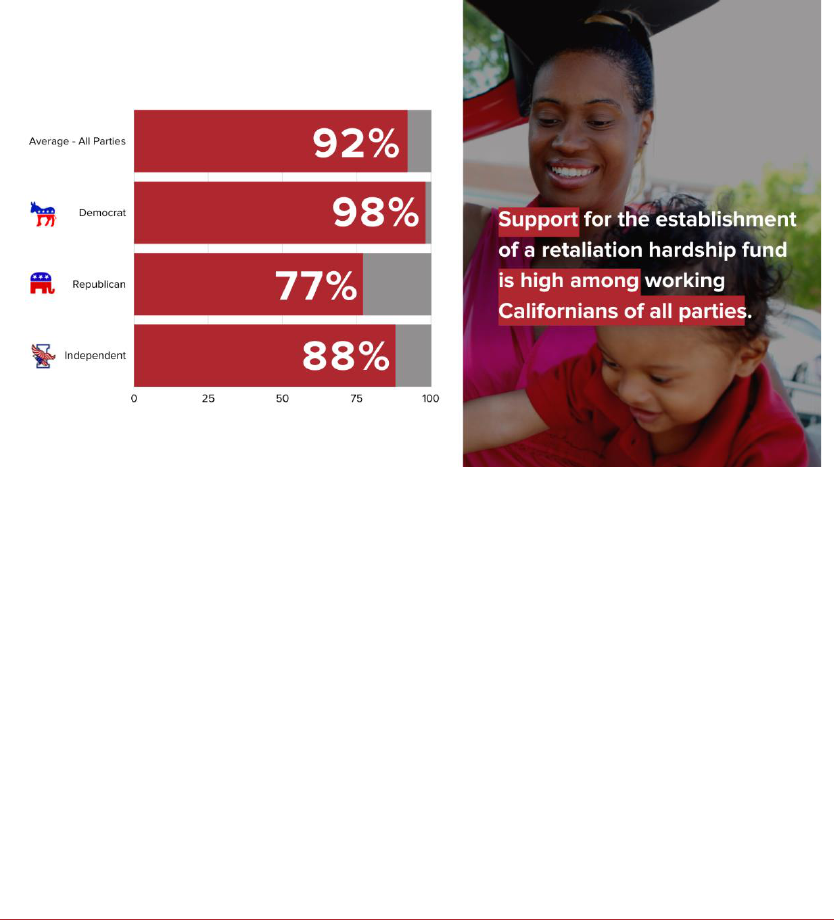
NELP | HOW CA CAN LEAD ON RETALIATION REFORMS TO DISMANTLE WORKPLACE INEQUALITY | NOV 2022
20
collected from employers who are found to have retaliated unlawfully.
The concept of a retaliation fund is not new. As NELP outlined in a 2021 report on
retaliation funds, worker organizations have long used different types of mutual support
funds to assist workers in exercising their rights.
53
California also already operates
restitution funds for garment
54
and car wash workers
55
who are unable to obtain the
compensation they are owed by employers through the legal system.
Such a fund could encourage significantly more workers to come forward with workplace
violations. Our survey found that for more than two in three California workers, access to a
retaliation hardship fund could help them report a future violation to a government
agency. And an overwhelming majority of working Californians—92 percent—support the
establishment of a retaliation hardship fund that would provide one-time financial
assistance to workers who file good-faith complaints about employer retaliation. Appendix
A outlines how such a fund in California could be structured and function.
B. Simplify California’s Anti-Retaliation Laws to Help Workers Understand and Assert
Their Rights
Lawmakers should create consistency across the state’s Labor Code provisions addressing
retaliation so that workers can more easily understand and enforce their rights. As part of
this process, lawmakers should consistently apply existing laws that presume any harmful
action an employer takes against a worker within 90 days after the worker asserts a basic
workplace right is retaliation. For example, under existing law, California employers are
presumed to have committed retaliation within 90 days and must prove otherwise in the
warehouse and fast-food industry, as well as when their actions include immigration-
related threats.
56
Lawmakers should also ensure that any penalties paid by employers, such
as the up to $10,000 penalty for retaliation, goes to the worker rather than to the general
fund.

NELP | HOW CA CAN LEAD ON RETALIATION REFORMS TO DISMANTLE WORKPLACE INEQUALITY | NOV 2022
21
California’s laws need to be strongly worded and strongly enforced. When workers file
complaints of retaliation with the Labor Commissioner’s office, they should feel confident
that their claims will be handled with the appropriate urgency. Unfortunately, despite
increases in funding in the 2022 state budget, the Labor Commissioner’s Retaliation
Complaint Investigation Unit is still under-resourced, which creates challenges for enforcing
the more than 45 labor laws and resolving its large backlog of cases. Lawmakers should
substantially increase funding for the Retaliation Complaint Investigation Unit, which
receives considerably less funding than the Labor Commissioner’s Office Wage Claim
Adjudication unit and the Bureau of Field Enforcement.
C. Adopt a State “Just Cause” Law to Protect Workers from Unfair and Arbitrary Firings
Our survey found that a large majority—81 percent—of working Californians of all parties
support the adoption of laws protecting workers from unfair and arbitrary firings. Replacing
California’s at-will firing system with a just-cause termination standard would require
employers to provide legitimate reasons and fair warnings before terminating workers.
Effective just-cause policies also require employers to notify workers of performance
problems in advance and provide an opportunity to address them. And, when workers are
fired, such policies guarantee severance pay or, if they were terminated without just cause,
a right to reinstatement. Finally, by requiring a good reason for terminations, just-cause
protections more effectively protect workers from retaliation when they insist on other
workplace rights. Appendix B outlines the key provisions a California just-cause law should
contain.
VII. Conclusion
The wellness of individual workers, their families, and their communities depends on their
ability to thrive inside and outside of work. That is only possible when workers can fully
exercise and enforce their workplace rights without concern for losing their jobs. Current
California laws, however, perpetuate a deep power imbalance between workers and their
employers that forces workers into harmful, unjust, and unstable working conditions. This
power imbalance stems from unjust and arbitrary firings permitted under California’s at-
will employment system, rampant retaliation by employers, and economic insecurity.
California workers simply have too much to lose if they raise concerns at work or report
violations, despite existing anti-retaliation laws. A just-cause standard to end unfair firings,
in addition to a retaliation fund to provide immediate economic support for workers
contesting retaliatory job actions, would put California’s workers on much stronger footing
to demand better workplace conditions and to hold employers accountable.

NELP | HOW CA CAN LEAD ON RETALIATION REFORMS TO DISMANTLE WORKPLACE INEQUALITY | NOV 2022
22
Appendix A – Key Elements of a Retaliation
Fund
What is a retaliation fund?
• A retaliation fund allows a worker who has filed a wage-theft or other complaint
with a state agency to access quick and meaningful financial assistance when their
employer fires them or cuts part of their pay because of that complaint.
• Retaliation funds directly fill the urgent gap left by California’s existing anti-
retaliation statutes under which it can take months, if not years, for a worker to
obtain a final decision on a retaliation complaint.
• Retaliation funds are not entirely new. As NELP outlined in its 2021 report on
retaliation funds,
57
worker organizations have long used different types of mutual
support funds to aid workers in exercising their rights.
• A variety of public and private economic hardship funds have played an important
role in supporting workers and families. During the COVID-19 pandemic, for
example, cities and states like Boston, New York City, Atlanta, San Antonio, Tucson,
and Washington, DC established hardship funds to support impacted individuals
and families.
58
Prior to the pandemic, states and localities proved that
governments could establish funds to provide financial support to workers and
others in a wide range of contexts. The federal Emergency Food and Shelter
Program, for example, distributes funds to local governments that, in turn,
distribute the funds to private nonprofit organizations who provide financial
assistance to individuals facing economic hardship.
59
All states, including California,
operate a compensation fund to provide financial support to victims of crime.
60
• California also funds and operates restitution funds for garment
61
and car wash
workers
62
who are unable to obtain the compensation they are owed by employers
through the legal system. (Maine and Oregon operate similar funds for workers
that are not industry specific.) In addition, California law has established the Travel
Consumer Restitution Corporation, a fund to help California consumers who “suffer
losses as a result of the bankruptcy, cessation of operations, insolvency, or material
failure of a seller of travel to provide. . .transportation or travel services
contracted.”
63
»

NELP | HOW CA CAN LEAD ON RETALIATION REFORMS TO DISMANTLE WORKPLACE INEQUALITY | NOV 2022
23
What kind of retaliation would the retaliation fund cover?
• A worker would be able to receive financial support from the retaliation fund if
their employer fired them or reduced their pay in any way because the worker filed
a complaint about the employer with a state agency. The retaliation fund must
define “adverse actions” broadly given the countless and often subtle ways in
which employers retaliate. At a minimum, an “adverse action” that results in losing
one’s job or pay should include the following:
o firing a worker
o constructive discharging (where the employer creates a work
environment that forces a worker to leave the job)
o demoting a worker
o blacklisting that keeps a worker from finding a new job
o reducing hours
o changing schedules in a way that impacts income
o making immigration-based threats that force a worker to leave the job
o reducing pay in other ways
How much support should a worker recover from the retaliation fund?
• A worker should be able to obtain a one-time financial assistance payment from the
retaliation fund. This arrangement can draw from existing hardship models where one-
time payments are not considered taxable income, making it easier for agencies to
administer.
• In California, workers should be able to obtain at least $2,500 as a one-time payment.
• The primary objective in setting the amount of financial assistance available to workers
through a retaliation fund is to ensure that financial support can meaningfully help sustain
a worker while searching for a new job, processing their retaliation complaint, and
responding to the financial and related consequences of losing a job or part of their pay
due to retaliation.
How would a retaliation fund be funded?
• A California retaliation fund could be funded for an initial period of time with state general
funds. The state can divert penalties for retaliation to maintain the retaliation fund in the
future.
• Workers should not have to repay financial support received through the fund. The
burden of repaying into the fund should fall to employers who are found to have
retaliated unlawfully.

NELP | HOW CA CAN LEAD ON RETALIATION REFORMS TO DISMANTLE WORKPLACE INEQUALITY | NOV 2022
24
• When a worker receives financial support from the retaliation fund, if the worker’s
employer is found to have unlawfully retaliated after a full investigation or court decision,
the employer should be required to replenish the fund with three times the amount of
financial support that the worker received. This would be similar to the way a growing
number of states and cities, including California, require employers to pay treble (i.e.,
three times) damages for wage theft.
How would workers access the fund? Who would be eligible?
• Accessing financial support from a retaliation fund should be as simple as possible in order
to provide support to a worker immediately after they lose their job or part of their pay
due to retaliation.
• The following steps can help ensure quick access to meaningful financial support:
o Step 1. A worker files a complaint with a state labor-enforcement agency alleging an
employer violation (e.g., the worker submits a wage-theft complaint to the Labor
Commissioner).
o Step 2. The state labor-enforcement agency that receives a worker’s complaint sends
a notice of the complaint to the employer(s) named in the complaint, or the agency
obtains evidence that the employer became aware of the complaint filed.
o Step 3. If the employer fires the worker or reduces the worker’s pay in what the
worker reasonably believes amounts to retaliation for filing their complaint, the
worker submits a good-faith complaint alleging retaliation to the labor-enforcement
agency charged with administering the retaliation fund within 90 days of the alleged
retaliation along with a request for financial support from the fund.
o Step 4. The agency that administers the retaliation fund will review the request for
financial support and issue a one-time payment to the worker as soon as possible.
Critically, a worker should not have to wait until an investigation or court case
determines whether retaliation occurred, because that takes months, if not years,
and the delay would defeat the purpose of the fund: to provide support when a
worker needs it most. In implementing a retaliation fund, the implementing agency
must seek to support the worker when a worker has alleged retaliation in good faith.
What safeguards can help avoid potential misuse?
• While nothing should suggest that the proposed retaliation fund would be vulnerable to
misuse by workers, some safeguards can assuage potential doubts:

NELP | HOW CA CAN LEAD ON RETALIATION REFORMS TO DISMANTLE WORKPLACE INEQUALITY | NOV 2022
25
o The fund should only be available to workers who have filed a complaint with a labor-
enforcement agency. Agencies can retain their existing discretion over whether to
investigate each and every complaint.
o If, in the course of an investigation, a worker is found to have intentionally lied or
fabricated evidence, the agency administering the retaliation fund could revoke that
worker’s eligibility for all future support from the fund.
What is the role of community partnerships in successful implementation of a fund?
• Worker leaders, advocates, academics, and others with experience addressing wage-
theft and other violations have long emphasized the need for enforcement agencies to
form close partnerships with local, community-based organizations. In establishing a
retaliation fund, California lawmakers should also ensure that the fund administrator can
engage effectively with community organizations to successfully implement the fund,
including through grants and formal agreements that allow community-based groups to
conduct outreach, educate, help process complaints and requests for financial support,
and so on.

NELP | HOW CA CAN LEAD ON RETALIATION REFORMS TO DISMANTLE WORKPLACE INEQUALITY | NOV 2022
26
Appendix B – Key Provisions of a “Just
Cause” Law
1. Good reason for discharge – The core of a just-cause employment system is a
requirement that the employer must show that there is a justifiable reason for
discharging a worker, such as poor work performance that does not improve after
feedback and coaching, violation of important employer policies, or employee
misconduct. Just-cause systems also allow employers to discharge workers for
bona fide economic reasons, such as when business declines or a position is no
longer needed, without a need to show just cause.
2. Duty on the employer – Under a just-cause system, the employer is responsible for
demonstrating a good reason for discharging the worker—the reverse of the
current system, where employees must demonstrate that a firing was for an
impermissible reason. Shifting that responsibility to the employer is widely
recognized as key for protecting workers against arbitrary and unfair firings,
including against firings that are currently illegal but where workers have difficulty
enforcing their rights, such as in cases of racial discrimination or retaliation against
whistleblowers.
3. Certain activities are categorically protected – Just-cause legislation should also
clarify that certain reasons are categorically not grounds for discharge. Examples of
categorically protected employee activities should include: (1) communicating to
any person, including other employees, government agencies, or the public about
job conditions; and (2) refusing to work under conditions that the employee
reasonably believes would expose them, other employees, or the public to an
unreasonable threat of illness or injury on the job.
4. Fair notice to workers and opportunity to address problems – Another key
component is fair notice to the worker of any performance problems and the
opportunity to address them before being discharged. This process, which is often
called “progressive discipline,” is well established. It also mirrors the process that
many responsible employers already use: giving employees feedback and coaching
on performance issues and support in addressing them before getting to the point
of possible discharge. However, a just-cause policy should make clear that certain
kinds of serious misconduct may trigger a bypass of the progressive discipline
process and allow for immediate employer action. These should include conduct
that threatens the safety or well-being of other people, such as violence or
harassment.
5. Equal coverage of temp and staffing employees – Economic theory suggests that if
it becomes more difficult for employers to discharge workers, they will shift
employment to temp and staffing agencies because such employees are generally
»

NELP | HOW CA CAN LEAD ON RETALIATION REFORMS TO DISMANTLE WORKPLACE INEQUALITY | NOV 2022
27
not subject to the same standards. Therefore, it is crucial that just-cause
employment protections apply equally to employees working through temp or
staffing agencies. A just-cause policy should expressly address these issues—for
example, by requiring the same showing of just cause for ending employment.
6. Limits on defined-term employment – Another key consideration for a just-cause
policy is under what circumstances to allow employers to hire workers for defined
projects or terms, after which their employment can end without a need to
demonstrate just cause. Examples of reasonable defined-term employment might
include short-term, seasonal jobs in industries that need additional staffing during
certain times of the year, and projects for which the need for employees or the
funding to pay them will end once the project is completed. However, it is
important that such authorization for defined-term employment be limited to
clearly defined circumstances that prevent it from becoming a loophole through
which employers can meet ongoing staffing needs. In addition, during the course of
such defined-term employment, just-cause protections against early discharge
should apply.
7. Protections to ensure economic discharges are not a loophole – It is important to
ensure that economic (i.e., non-performance-based) discharges, when they are
necessary, do not become a means for sidestepping just-cause protections.
Employers should be allowed to make economic discharges when business
conditions warrant, but there should be standards for demonstrating their
necessity to ensure they are not used to disguise otherwise impermissible
discharges.
8. Protections against intensive surveillance and monitoring – Just-cause legislation
is an opportunity to begin to address the harmful and discriminatory impact of
employers’ growing use of electronic surveillance, algorithmic decision-making,
and automated employee evaluation systems. Electronic monitoring and decision-
making can result in employees being disciplined and even discharged with little
human involvement in those assessments. Pervasive monitoring of workers also
means that minor infractions can easily be found and used to sidestep just-cause
protections. Just-cause legislation should limit the use of data collected through
electronic monitoring for termination and disciplinary decisions.
9. Severance pay – When workers are discharged—whether for just cause or
economic reasons—providing severance pay is crucial for mitigating the very
harmful economic impacts of job loss. Without severance pay, workers and families
face dramatic income cuts and extreme hardship, including being unable to pay
rent or a mortgage, potentially leading to eviction or foreclosure. To provide
workers with a cushion as they search for new employment, just-cause protections
should guarantee a basic period of severance pay, such as four weeks.
Guaranteeing severance pay is not only fair and broadly popular, but it also avoids

NELP | HOW CA CAN LEAD ON RETALIATION REFORMS TO DISMANTLE WORKPLACE INEQUALITY | NOV 2022
28
the common employer practice of pressuring workers to sign away their rights in
exchange for receiving severance pay.
10. Strong remedies and relief – A just-cause policy should include strong remedies for
violations, including the right to reinstatement and money damages, together with
additional penalties or liquidated damages that are sufficient to deter
noncompliance. Money damages must reflect the full scope of damages that
workers face. Without such meaningful sanctions for discharges without cause, any
new just-cause policy would not achieve the goal of ensuring fair process before
workers are subjected to job loss.
11. Effective enforcement vehicles, including qui tam – Government labor agencies
simply do not have the capacity to adequately enforce employment protections on
their own. Therefore, a just-cause policy should include effective tools to allow
workers to bring enforcement actions on their own. These should include a private
right of action, authorization for recovery of attorneys’ fees, and authorization for
“qui tam” enforcement. Similar to a private right of action, qui-tam enforcement
allows workers and members of the public to supplement government agency
enforcement by stepping into the government’s shoes to bring enforcement
proceedings as “private attorneys general.” Significantly, it can allow
representative organizations, such as unions or worker centers, to bring
enforcement action, ensuring that the burden of challenging employer lawbreaking
does not remain solely on individual workers, who may face retaliation.
12. No waivers of rights permitted – A just-cause policy should provide that workers’
rights may not be waived through private agreements absent court or Department
of Labor supervision and explicitly prohibit employers from requiring workers to
enter into a private agreement to waive their just-cause and whistleblower rights.
13. Rights that are enforceable before judges and juries, regardless of forced
arbitration requirements and class/collective-action waivers – Finally, a just-cause
policy should ensure that its protections can be enforced by workers before judges
and juries. Forced arbitration requirements deny workers the right to go before a
judge and jury when their employer breaks the law. Instead, workers must bring
any claims to a secret proceeding before a private arbitrator who is not
accountable to the public. Because these arbitrators depend on corporations for
repeat business, they strongly favor employers. Making matters even worse, class
and collective-action waivers routinely incorporated into these requirements
prevent groups of employees from banding together to challenge employer
lawbreaking. An effective just-cause policy must ensure that forced arbitration
requirements and class/collective-action waivers will not interfere with the ability
of workers to enforce their rights under that policy.

NELP | HOW CA CAN LEAD ON RETALIATION REFORMS TO DISMANTLE WORKPLACE INEQUALITY | NOV 2022
29
Appendix C – Survey Methodology
Between January 7 and January 23, 2022, YouGov interviewed 1,152 respondents through
an online survey. The respondents were then matched down to a sample of 1,000 to
produce the final dataset. Respondents were collected as part of a California state
representative sample as well as California resident oversamples of Black and Latinx
respondents.
The respondents were matched to a sampling frame representing employed residents
between 18 and 64 years of age. The sampling frame consisted of interlocking parameters
of gender, age, race, and education. The frame was constructed by stratified sampling from
the full 2020 Current Population Survey sample with selection within strata by weighted
sampling with replacements (using the person weights on the public use file).
The matched cases were weighted to the sampling frame using propensity scores. The
matched cases and the frame were combined, and a logistic regression was estimated for
inclusion in the frame. The propensity score function included age, gender, race/ethnicity,
years of education, and region. The propensity scores were grouped into deciles of the
estimated propensity score in the frame and post-stratified according to these deciles.
The weights were then post-stratified on a four-way stratification of gender, age (4-
categories), race (4-categories), and education (4-categories), to produce the final weight.
The margin of error for the entire survey is ±3.6%
»

NELP | HOW CA CAN LEAD ON RETALIATION REFORMS TO DISMANTLE WORKPLACE INEQUALITY | NOV 2022
30
Endnotes
1
California Coalition for Worker Power (CCWP)
Focus Group with California members of Fight for 15
and a Union, in Spanish, held in September 2021. On
file with author.
2
Chinese Progressive Association and Asian
Americans Advancing Justice – Asian Law Caucus,
Press Release, August 21, 2021,
https://cpasf.org/updates/workers-at-popular-
chinatown-restaurant-win-1-61-million-in-massive-
wage-theft-settlement/.
3
“Overview,” U.S. Equal Employment Opportunity
Commission, accessed November 2, 2021,
https://www.eeoc.gov/overview.
4
“Laws that Prohibit Retaliation and
Discrimination,” California Department of Industrial
Relations, accessed November 2, 2021,
https://www.dir.ca.gov/dlse/HowToFileLinkCodeS
ections.htm.
5
Kevin Kish, 2019 Annual Report, Department of
Fair Employment and Housing,
https://www.dfeh.ca.gov/wp-
content/uploads/sites/32/2020/10/DFEH_2019An
nualReport.pdf.
6
“FY 2009 – 2020 EEOC Charge Receipts for CA,”
U.S. Equal Employment Opportunity Commission,
accessed October 29, 2021,
https://www.eeoc.gov/statistics/enforcement/char
ges-by-state/CA.
7
Julie A. Su, 2017 Retaliation Complaint Report
(Labor Code §98.75), State of California Department
of Industrial Relations,
https://www.dir.ca.gov/dlse/RCILegReport2017.pd
f.
8
Patricia K. Huber, 2018 Retaliation Complaint
Report (Labor Code §98.75), State of California
Department of Industrial Relations,
https://www.dir.ca.gov/dlse/RCILegReport2018.pd
f.
9
Lilia García-Brower, 2019 Retaliation Complaint
Report (Labor Code §98.75), State of California
Department of Industrial Relations,
https://www.dir.ca.gov/dlse/RCILegReport2019.pd
f.
10
Lilia García-Brower, 2020 Retaliation Complaint
Report (Labor Code §98.75), State of California
Department of Industrial Relations,
https://www.dir.ca.gov/dlse/RCILegReport2020.pd
f.
11
Kevin Kish, 2017 Annual Report, Department of
Fair Employment and Housing,
https://www.dfeh.ca.gov/wp-
content/uploads/sites/32/2018/08/August302018
AnnualReportFinal.pdf (the 2017 annual report
refers to retaliation complaints as those concerning
“engagement in a protected activity”).
12
Kevin Kish, 2018 Annual Report, Department of Fair
Employment and Housing, https://www.dfeh.ca.gov/wp-
content/uploads/sites/32/2020/01/DFEH-AnnualReport-
2018.pdf.
13
Kish, 2019 Annual Report.
14
Kish, 2018 Annual Report.
15
Kish, 2018 Annual Report.
16
Kish, 2019 Annual Report.
17
See, e.g., Advancing Justice - Asian Law Caucus and
University of California, Berkeley Labor Occupational
Health Program, Few Options, Many Risks: Low-Wage Asian
and Latinx Workers in the COVID-19 Pandemic, April 2021,
https://www.advancingjustice-
alc.org/news_and_media/covid-workers-report; Rakeen
Mabud, Amity Paye, Maya Pinto, and Sanjay Pinto,
Foundations for a Just and Inclusive Recovery: Economic
Security, Health and Safety, and Agency and Voice in the
COVID-19 Era, Color of Change, National Employment Law
Project, TIME’S UP Foundation, and The Worker Institute
at Cornell ILR, February 2021,
https://www.nelp.org/publication/foundations-for-a-just-
and-inclusive-recovery; San Diego State University
Department of Sociology, Center on Policy Initiatives, and
Employee Rights Center of San Diego, Confronting Wage
Theft: Barriers to Claiming Unpaid Wages in San Diego, July
2017,
https://ccre.sdsu.edu/_resources/docs/reports/labor/Con
fronting-Wage-Theft.pdf; Jora Trang, Improving OSH
Retaliation Remedies for Workers, Worksafe, June 2015,
https://worksafe.org/file_download/inline/54b22018-
1128-4141-842c-aebc9cdccf23; and Eileen Appelbaum and
Ruth Milkman, Leaves That Pay: Employer and Worker
Experiences with Paid Family Leave in California, 2011,
https://cepr.net/documents/publications/paid-family-
leave-1-2011.pdf.
18
CCWP Focus Groups with California members of the
Pilipino Association of Workers and Immigrants (PAWIS),
in Tagalog, held in August 2021. On file with author.
19
Institute for the Future for the California Future of Work
Commission, Future of Work in California: A New Social
Compact for Work and Workers, March 2021,
https://www.labor.ca.gov/wp-
content/uploads/sites/338/2021/02/ca-future-of-work-
report.pdf.
20
“Hunger Data,” California Association of Food Banks,
https://www.cafoodbanks.org/hunger-
data/#:~:text=On%20average%2C%201%20out%20of,by
%20Black%20and%20Latinx%20families.&text=This%20
data%20is%20based%20off,not%20comparable%20to%2
0Phase%202 and Diane Schanzenbach and Natalie Tomeh,
“Visualizing Food Insecurity”, Northwestern Institute for
Policy Research, July 14, 2020,
https://www.ipr.northwestern.edu/state-food-
insecurity.html (selecting for California, 23.9 percent of
Black and 24.9 percent of Latinx respondents reported
food insecurity).
21
Robert P. Jones, Daniel Cox, Rob Griffin, Maxine
Najle, Molly Fisch-Friedman, and Alex Vandermaas-
Peeler, A Renewed Struggle for the American Dream:
PRRI 2018 California Workers Survey, PRRI, 2018,
https://irvine-dot-
»

NELP | HOW CA CAN LEAD ON RETALIATION REFORMS TO DISMANTLE WORKPLACE INEQUALITY | NOV 2022
31
org.s3.amazonaws.com/documents/295/attachmen
ts/2018_PRRI_California_Workers_Survey.pdf?1535
415254.
22
Catherine S. Harvey, “Unlocking the Potential of
Emergency Savings Accounts,” AAPR Public Policy
Institute, October 2019,
https://www.aarp.org/content/dam/aarp/ppi/201
9/10/unlocking-potential-emergency-savings-
accounts.doi.10.26419ppi.00084.001.pdf.
23
Harvey, 2019.
24
Board of Governors of the Federal Reserve
System, Report on the Economic Well-Being of U.S.
Households in 2018 – May 2019, last updated May 28,
2019,
https://www.federalreserve.gov/publications/2019
-economic-well-being-of-us-households-in-2018-
dealing-with-unexpected-expenses.htm.
25
Board of Governors of the Federal Reserve
System, 2019.
26
Alissa Anderson, Q&A: Unemployment Insurance,
Labor Day Cliff & the Costs of Unemployment,
California Budget & Policy Center, August 2021,
https://calbudgetcenter.org/resources/qa-
unemployment-insurance-labor-day-cliff-the-costs-
of-unemployment/
27
Anderson, 2021.
28
See, e.g., Lauren Hepler, “Is California blowing it
on unemployment reform?,” CalMatters, March 29,
2021, Economy,
https://calmatters.org/economy/2021/03/californi
a-unemployment-crisis-reform/; Marie Tae
McDermott and Jill Cowan, “What to Know About the
Delays in California’s Unemployment Payments,”
New York Times, January 19, 2021, California Today,
https://www.nytimes.com/2021/01/19/us/ca-
unemployment-payments.html; “Governor Newsom
Signs Legislation to Strengthen State Unemployment
Insurance Delivery System,” Office of Governor
Gavin Newsom, October 5, 2021,
https://www.gov.ca.gov/2021/10/05/governor-
newsom-signs-legislation-to-strengthen-state-
unemployment-insurance-delivery-system.
https://www.gov.ca.gov/2021/10/05/governor-
newsom-signs-legislation-to-strengthen-state-
unemployment-insurance-delivery-system/
29
“Responding to Unemployment Insurance Claim
Notices,” Employment Development Department,
State of California, updated February 17, 2022,
https://edd.ca.gov/en/Unemployment/Responding_
to_UI_Claim_Notices.
30
Sara Kimberlin, Aureo Dias Mesquita, and Kristin
Schumacher, Undocumented & Mixed-Status Families Are
Blocked From Food Support, California Budget & Policy
Center, May 2021,
https://calbudgetcenter.org/resources/undocumented-
mixed-status-families-are-blocked-from-food-support/;
Rebecca Smith, Immigrant Workers’ Eligibility for
Unemployment Insurance, National Employment Law
Project, March 31, 2020,
https://www.nelp.org/publication/immigrant-workers-
eligibility-unemployment-insurance/.
31
Laura Huizar, Exposing Wage Theft Without Fear: States
Must Protect Workers from Retaliation, National
Employment Law Project, June 2019,
https://s27147.pcdn.co/wp-content/uploads/Retal-
Report-6-26-19.pdf.
32
“Laws that Prohibit Retaliation and Discrimination,”
California Department of Industrial Relations, accessed
November 2, 2021,
https://www.dir.ca.gov/dlse/HowToFileLinkCodeSections.
htm.
33
“Chapter 4. Division of Labor Standards Enforcement,”
California Labor Code, Division 1. Department of Industrial
Relations,
https://leginfo.legislature.ca.gov/faces/codes_displaySecti
on.xhtml?lawCode=LAB§ionNum=98.6; “Chapter 5.
Political Affiliations,” California Labor Code, Division 2.
Employment Regulation and Supervision, Part 3. Privileges
and Immunities,
https://leginfo.legislature.ca.gov/faces/codes_displaySecti
on.xhtml?lawCode=LAB§ionNum=1102.6
34
See, e.g., Daniel Costa, California Leads The Way: A Look
at California Laws That Help Protect Labor Standards for
Unauthorized Immigrant Workers, Economic Policy
Institute, March 22, 2018,
https://www.epi.org/publication/california-immigrant-
labor-laws/.
35
Davis Wright Tremaine LLP, “New California Law Raises
the Stakes in Labor Commissioner Investigations and
Whistleblower Suits,” JD Supra, October 17, 2017,
https://www.jdsupra.com/legalnews/new-california-law-
raises-the-stakes-in-90245/.
36
See, e.g., Lisa P. Mak, “Protecting Whistleblowers:
Litigating Claims under Labor Code Section 1102.5,”
Advocate Magazine, May 2021,
https://www.advocatemagazine.com/article/2021-
may/protecting-whistleblowers (outlining how workers
who litigate a retaliation claim under Labor Code Section
1102.5 have been subject to the McDonnell Douglas
burden-shifting standard which places “the ultimate
burden of persuasion” with the worker and under which an
employer must “merely produce evidence of “legitimate,
non-retaliatory reasons for the adverse action, but it does
not need to persuade the trier of fact that it was actually
motivated by those reasons”); Jenny R. Yang and Jane Liu,
Strengthening Accountability for Discrimination, Economic
Policy Institute, January 19, 2021 (discussing hurdles to
bringing federal discrimination claims and explaining that
“workers who file lawsuits face substantial barriers in
succeeding on their claims in court due to the onerous legal
standards” that “create enormous evidentiary hurdles for
workers and disregard the reality of extreme information
asymmetry where workers often lack access to the
evidence that courts require to support employment
discrimination claims”). Notably, the California Supreme
Court has agreed to hear a case to determine whether the
McDonnell Douglas burden-shifting standard applies to
claims brought pursuant to Labor Code Section 1102.5 or
whether Labor Code Section 1102.6 replaces that burden-
shifting framework. Lawson v. PPG Architectural Finishes

NELP | HOW CA CAN LEAD ON RETALIATION REFORMS TO DISMANTLE WORKPLACE INEQUALITY | NOV 2022
32
(Case No. S266001) (Cal. Sup. Ct., received from the 9th Cir.
On Dec. 8, 2020).
37
Kevin Kish, Tracking Outcomes: 2019 Report to the
Joint Legislative Budget Committee, Department of
Fair Employment and Housing, March 1, 2019,
https://www.dfeh.ca.gov/wp-
content/uploads/sites/32/2019/03/2019.03.01_DF
EH_LAO_SupplementalReport.pdf (In 2018, only 64
percent of cases closed within 100 days. Eighty-
three percent of cases closed within 180 days, 93
percent closed within 275 days, and all cases closed
within 365 days).
38
Kish, 2019.
39
California Department of Industrial Relations, FY
2019 Comprehensive Federal Annual Monitoring
Evaluation (FAME) Report,
https://www.osha.gov/sites/default/files/2020-
07/california_2019.pdf.
40
“What You Can Expect After You File a Charge,”
U.S. Equal Employment Opportunity Commission,
https://www.eeoc.gov/what-you-can-expect-after-
you-file-charge.
41
Eunice Hyunhye Cho, Tia Koonse, Anthony Mischel,
”Hollow Victories: The Crisis in Collecting Unpaid
Wages for California’s Workers,” National
Employment Law Project and UCLA Labor Center
(June 2013) https://s27147.pcdn.co/wp-
content/uploads/2015/02/Hollow-Victories.pdf
42
Kate Andrias and Alexander Hertel-Fernandez,
Ending At-Will Employment: A Guide for Just Cause
Reform, Roosevelt Institute, January 19, 2021,
https://rooseveltinstitute.org/publications/ending-
at-will-employment-a-guide-for-just-cause-reform/.
43
Fair Work Act 2009 (Cth) s 387 (Austl.); C.L.T. art.
482 (Braz.); KSchG § 1(2) (Ger.); Unfair Dismissals
Act 1977 § 6(4) (Ir.); Labor Contract Act, art. 16
(Japan); LFT art. 47 (Mex.); Employment Rights Act,
c. 18, § 98 (Gr. Brit.)
44
Clyde W. Summers, Employment at Will in the
United States: The Divine Right of Employers 3, U.
Pa. J. Lab. & Emp. L. 1, 65-86, (2000),
https://www.law.upenn.edu/journals/jbl/
articles/volume3/issue1/Summers3U.Pa.J.Lab.&Em
p.L.65(2000). pdf; Herbert G. Gutman, Trouble on
the railroads in 1873–1874: Prelude to the 1877
crisis?, Labor History, 2, 2, 1961, https://www.
tandfonline.com/doi/abs/10.1080/0023656610858
3874?journalCo de=clah20
45
Christian E. Weller, African Americans Face
Systematic Obstacles to Getting Good Jobs, Center for
American Progress, December 5, 2019,
https://www.americanprogress.org/issues/econom
y/reports/2019/12/05/478150/african-americans-
face-systematic-obstacles-getting-good-jobs/.
46
Wei-hsin Yu and Shengwei Sun, Falling in and
Getting Out of Unemployment: Ethnoracial and Class
Differences across Business Cycles, prepared for the
U.S. DEPARTMENT OF LABOR,
https://www.dol.gov/sites/dolgov/files/OASP/lega
cy/files/Yu-DOL-Final-Paper.pdf.
47
CCWP Focus Group with California members of
the CLEAN Carwash Worker Center, in Spanish, held
in October 2021. On file with author.
48
CCWP Focus Group with California members of
the Pilipino Worker Center, in English, held in
October 2021. On file with author.
49
CCWP Focus Group with California members of the
Pilipino Worker Center, in English, held in October
2021. On file with author.
50
CCWP Focus Group with California members of the
Chinese Progressive Association, in Cantonese and
Mandarin, held in October 2021. On file with author.
51
The Council of State Governments Justice Center, Confined
and Costly: How Supervision Violations Are Filling Prisons and
Burdening Budgets, June 18, 2019,
https://csgjusticecenter.org/wp-
content/uploads/2020/01/confined-and-costly.pdf.
52
Noah Zatz, Tia Koonse, Theresa Zhen, Lucero Herrera, Han
Lu, Steven Shafer, and Blake Valenta, Get to Work or Go to
Jail: Workplace Rights Under Threat, UCLA Institute for
Research on Labor and Employment, March 2016,
https://irle.ucla.edu/wp-content/uploads/2016/03/Get-
To-Work-or-Go-To-Jail-Workplace-Rights-Under-Threat.pdf.
53
Laura Huizar, Retaliation Funds: A New Tool to Tackle
Wage Theft, National Employment Law Project, April 2021,
https://s27147.pcdn.co/wp-content/uploads/NELP-Policy-
Brief-Retaliation-Funds.pdf.
54
“Garment Workers Will No Longer Wait Years for Stolen
Wages,” Bet Tzedek, June 29, 2019,
https://www.bettzedek.org/2019/06/garment-workers-
will-no-longer-wait-years-for-stolen-wages/.
55
California Labor Code § 2065.
56
California Labor Code §§ 2105 and 1019 (c); Bill
text of the Fast Food Accountability and Standards
Recovery Act,
https://leginfo.legislature.ca.gov/faces/billTextClie
nt.xhtml?bill_id=202120220AB257.
57
Huizar, April 2021.
58
“DHCD Tenant-Based Rental Assistance Program,”
Government of the District of Columbia, accessed November
2, 2021, https://coronavirus.dc.gov/page/dhcd-tenant-
based-rental-assistance-program; “Boston Resiliency Fund,”
City of Boston, accessed November 2, 2021,
https://www.boston.gov/departments/treasury/boston-
resiliency-fund; “COVID-19 Emergency Relief Fund,” City of
New York, accessed November 2, 2021,
https://www1.nyc.gov/site/fund/initiatives/covid-19-
emergency-relief-fund-
ds.page#:~:text=In%20response%2C%20Mayor%20de%20
Blasio,hourly%20workers%2C%20including%20immigrant
%20workers; City of Atlanta, “Mayor Keisha Lance Bottoms
Announces Atlanta COVID-19 Emergency Rental Assistance
Program through United Way,” press release, August 20,
2020,
https://www.atlantaga.gov/Home/Components/News/New
s/13432/672; “COVID-19 & Texas Law: Rent & Legal
Assistance,” Texas State Law Library, accessed November 2,
2021, https://guides.sll.texas.gov/covid-19/rent-legal-
assistance; Pablo Lopez, “Tucson City Council Approves
Additional COVID-19 Relief Funds,” KVOA.com, December 1,
2020, https://www.kvoa.com/coronavirus/tucson-city-
council-approves-additional-covid-19-relief-
funds/article_2c78e08e-ab62-54a8-94a9-
887e7edb1698.html.

NELP | HOW CA CAN LEAD ON RETALIATION REFORMS TO DISMANTLE WORKPLACE INEQUALITY | NOV 2022
33
59
“EFSP,” Emergency Food and Shelter National Board
Program, accessed on November 2,
2021,https://www.efsp.unitedway.org/efsp/website/index.
cfm.
60
“State Crime Victims Compensation,” Benefits.gov,
accessed November 2, 2021,
https://www.benefits.gov/benefit/4416; California
Government Code § 13900 et seq.
61
Bet Tzedek, 2019.
62
California Labor Code § 2065.
63
“What is the TCRC?,” Travel Consumer Restitution
Corporation, accessed November 2, 2021,
https://tcrcinfo.org/; California Business &
Professions Code § 17550.35 et seq.
